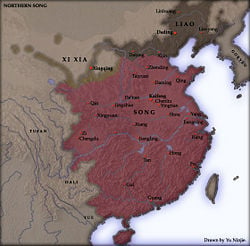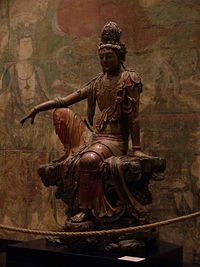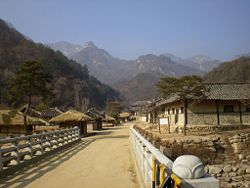Khitan people
The Khitan (or Khitai, Chinese: 契丹; pinyin: Qìdān), are an ethnic group that dominated much of Manchuria (Northeast China) in the tenth century. Chinese historians classified the Khitan as one of the Eastern proto-Mongolic ethnic groups Donghu (Simplified Chinese: 东胡族; Traditional Chinese: 東胡族; pinyin: Dōnghú zú). They established the Liao Dynasty in 907 but fell to the Jin Dynasty of the Jurchen in 1125. Following the fall of the Liao Dynasty, many moved further west and established the state of Kara Khitai. Their name survived in the Russian word for China (Китай, Kitay), as well as the archaic English (Cathay), Portuguese (Catai), and Spanish (Catay) appellations of the country.
Khitan had much in common with the Mongolians that came after them. The possessed a tribal culture and fought to preserve their ethnic identity, creating a Khitan script. Capable soldiers, but not as successful as the Mongolians, the Khitan's had little creative civilization to offer the regions defeated. After defeating Balhae dynasty in 936, the region passed through the hands of other regional powers over then following centuries, including the Mongols. Eventually, Khitan disappeared from history, with traces of the Khitans difficult to find today.
Early history of the Khitan
References to the Khitan in Chinese sources date back to the fourth century. The Yuwen clan of the Xianbei, an ethnic group situated in the area covered by the modern Liaoning province, preceeded the Khitans. After Murong clan conquered their regime, the remnants scattered in the modern-day Inner Mongolia, mixing with the original Mongolic population. They had been identified as a distinct ethnic group since paying tribute to the Northern Wei Dynasty in the mid-sixth century.
During the Tang Dynasty in China, the Khitan people fell under the control of the Uighurs. Once the Uighurs left their home in the Mongolian Plateau in 842, that created a power vacuum that gave the Khitan the opportunity to rise. The Khitan invaded the areas vacated by the Uighurs, bringing them under their control. The Khitan studied history, learning, on the one hand, the fearsome effect that the Uighur, Shatuo Turks, and Kirghiz steppe cavalry had on the Chinese. On the other hand, they noticed the effect that the adoption of Chinese writing and other tools of administration had on their cultural integrity. The Khitan knew of the Korean kingdom of Silla which they referred to as a little China. While their situation differed from Silla's in a number of ways, they wanted to avoid the fate that led to Unified Silla's fall.
Liao Dynasty
The Liao Dynasty, founded in 907 when Abaoji, posthumously known as Emperor Taizu, rose to leadership of the Khitan nation. Even though the declaration of the Great Liao Dynasty took place in 947, historians generally concur that the dynasty began with the elevation of Abaoji in 907. Abaoji, the founder of the Liao Dynasty, introduced a number of innovations, some more successful than others. He divided the empire into two parts, one governed based on nomadic models and the other, sedentary population, government largely in accordance with Chinese methods.
The introduction of primogeniture in succession to the proved less successful. Although he designed his eldest son heir, Abaoji's son failed to succeed him. Abaoji was
- afraid that their use of Chinese advisers and administrative techniques would blur their own ethnic identity, the Khitan made a conscious effort to retain their own tribal rites, food, and clothing and refused to use the Chinese language, devising a writing system for their own language instead."[1]
Scholars created the first of those two Khitan scripts in 920 and the second, based on alphabetic principles, five years later.
Relations with Korea
When the Khitan conquered the kingdom of Balhae, the border with Korea had been pushed to the Yalu River. Korea underwent significant transformations at the same time. Goryeo, founded in 918, eventually unified the entire Korean Peninsula. The Silla kingdom, which had ruled most of the peninsula since the seventh century, fell in 935. In 993, the Khitan invaded Goryeo's northwest border with 800,000 troops. They withdrew, ceding territory to the east of the Yalu River when Goryeo agreed to end its alliance with Song China. Goryeo continued to communicate with Song, having strengthened its position by building fortresses in the newly gained northern territories.
In 1010, Emperor Shengzong of Liao led a massive invasion with 800,000 men, commanding the army himself. He easily defeated the resisting army of General Gang Jo, whom the Khitans executed. Gang Gam-chan urged to King Hyeonjong to escape from the palace rather than surrender to invading Liao troops. King followed Gang Gam-chan's advice, managing to escape from the burning capital. A Korean insurgency began to harass Khitan forces. Finally Shengzong ordered a withdrawal of the entire force of Khitans; Khitans lost the war, and failed to gain any benefit from the campaign. That foreshadowed another bloody war between two nations as both sides remained hostile to each other. After the war, the king promoted Gang to the Minister of Government Administration.
In 1018, General Xiao Baiya of Liao invaded Goryeo with 100,000 men. This time, many officials urged to king to enter peace negotiations, since the damage from the Second Koryo-Khitan War proved so great Goryeo failed to recover from the damage. Gang again urged to the king to enter a war against Khitans, since the Khitan's brought a much smaller force to the battle line than previous invasions. He volunteered to serve as deputy commander-in-chief of Goryeo army at the age of 71. He led about 200,000 men toward the Goryeo-Liao border. General Gang won the first battle of the war, the Battle of Heunghwajin, by blocking the stream and destroying the dam while Khitans crossed. General Xiao persisted, aiming to capture the capital Kaesung, continuing to march southward. Later Xiao, realizing the impossibility of achieving the mission, decided to retreat. General Gang, knowing that Khitan army would withdraw from the war, waited for them at the fortress of Kwiju, where he encountered retreating Khitans in 1019 at the Battle of Kwiju. Discouraged and starving, Khitans lost the battle. Following Goryeo's victory in the Third Goryeo-Khitan War, peace came with Goryeo establishing a long-time friendly relationship with Liao.
Post Liao Dynasty history
Though Abaoji died in 926, the dynasty lasted nearly two more centuries. The Khitan's designated five cities as capitals during that dynasty. In addition to the Supreme Capital in the heartland of Khitan Territory, they established four regional capitals. One, Beijing, became a capital in the first time in its history, though not the principle capital of the Dynasty. Rather the Khitan's designated Beijing as the Southern Capital after the acquired the contentious Sixteen Prefectures in 935.
The Khitan, known as خطا in Arabic (Khata), mentioned by Muslim chroniclers, such as Ibn al-Athir, al-Thahabi and Ibn Khaldun. They had several clashes with the Khwarezmid Empire, winning at first, and imposing annual tribute on some, with territorial concessions (e.g. Khwarezmid handed Tirmiz over to them at one point). They eventually suffered a catastrophic defeat at the hands of Muhammad II of Khwarezm, no longer posing a serious threat to Muslims in adjacent regions. Although a number of the nobility of the Liao Dynasty escaped the area westwards towards Western Regions, establishing the short-lived Kara-Khitan or Western Liao dynasty, they were in turn absorbed by the local Turkic and Iranic populations and left no influence of themselves. As the Khitan language is still almost completely illegible, it is difficult to create a detailed history of their movements.
For a while after the invention of the Korean Hangeul script in the mid-fiteenth century, the name of the Khitans continued to appear in Korean texts as Georan/Kǒran (거란). The ethnonym eventually fell out of use, vanishing along with the distinct ethnic identity of the Khitan people. No clear evidence of any descendant ethnic groups of the Khitan in modern-day Northeast China exists, but some recent genetic studies have tended to support the hypothesis that the Daur ethnic group of Inner Mongolia contains at least some direct descendants of the ancient Khitan.[2]
See also
- Buraq Hajib
- Ethnic groups in Chinese history
- Goryeo-Khitan Wars
- Eagle hunting
Notes
- ↑ 2006 Encyclopaedia Britannica.
- ↑ DNA Match Solves Ancient Mystery Retrieved December 16, 2007.
ReferencesISBN links support NWE through referral fees
- Kuehn, Sara. 2006. Towards the Dragon and the Mythical Bird: Tracing Possible Antecedents for Some Elements of Khitan Iconography. Arts of Asia. 36 (5):67. OCLC: 104159080
- Mote, F.W. Imperial China: 900-1800. 1999. Harvard University Press. ISBN 0674012127
- Wittfogel, Karl August, and Chia-shêng Fêng. 1949. History of Chinese society: Liao, 907-1125. Philadelphia: American Philosophical Society: distributed by the Macmillan Co., New York. OCLC: 412297
- Xu, Elina-Qian. 2005. Historical development of the pre-dynastic Khitan. Publications of the Institute for Asian and African Studies, 7. Helsinki: University of Helsinki.
External Links
All links retrieved March 2, 2025.
- Chinese History - Liao Dynasty 遼 (907-1125); literature, thought, philosophy, and the Khitan script
- Kingdom of Khitans: Sudden Rise, Sudden Fall China.org
Credits
New World Encyclopedia writers and editors rewrote and completed the Wikipedia article in accordance with New World Encyclopedia standards. This article abides by terms of the Creative Commons CC-by-sa 3.0 License (CC-by-sa), which may be used and disseminated with proper attribution. Credit is due under the terms of this license that can reference both the New World Encyclopedia contributors and the selfless volunteer contributors of the Wikimedia Foundation. To cite this article click here for a list of acceptable citing formats.The history of earlier contributions by wikipedians is accessible to researchers here:
The history of this article since it was imported to New World Encyclopedia:
Note: Some restrictions may apply to use of individual images which are separately licensed.



